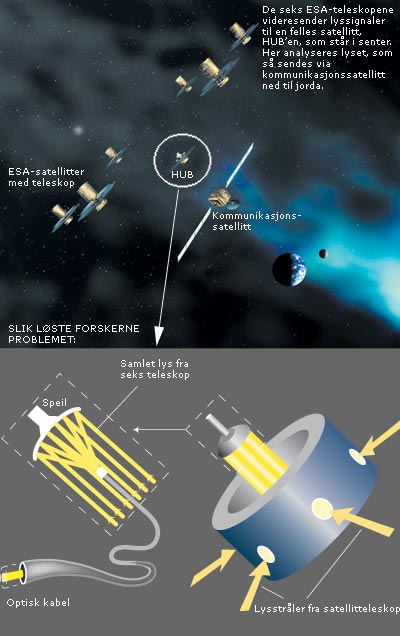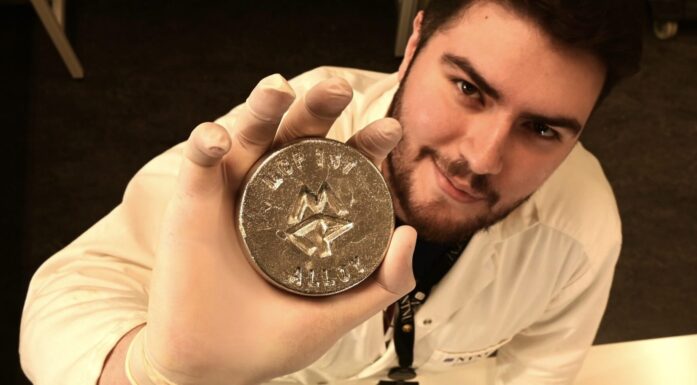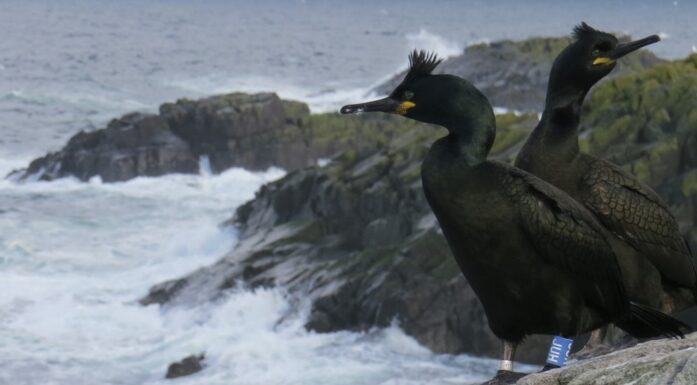Stargazing
They are working on one of the European Space Agency’s challenges: to collect the light from six telescopes in an optical fibre measuring just 1/50 mm. The goal is to find signs of life in distant space.
The six ESA telescopes will retransmit the light signals to a common satellite, the «hub», orbiting in the centre of the flotilla of telescopes. The hub satellite analyses the signals, which are then sent down to Earth via a communications satellite.
The fibre optic jigsaw puzzle is a small but vitally important component in the ESA Darwin project, which is looking for signs of life outside of our own solar system. Project researchers are looking farther afield than Mars – the part of space being investigated is several light years away from the red planet recently conquered with space vehicle and camera. The plan is to send into space an advanced remotecontrolled observatory by 2015.
SPECTRUM ANALYSIS
The planets being studied are so far away that it would take about one million years to travel there on today’s spacecraft. Researchers are therefore using a technique called spectrum analysis in their search for signs of life. In this case, that means analysing infrared lights from the planets.
“Light is made up of electromagnetic waves. The light’s infrared spectrum can tell us what substances and gases are present on the planet,” says researcher Steinar Neegård of SINTEF.
“Spectrum analyses can tell us if the three prerequisites for life as we know it – water, carbon dioxide and oxygen – exist somewhere out there.”
CATCHING LIGHT
One of the major challenges for the Darwin project is to capture the light from the planets. This is difficult, in part because of the luminous intensity of the stars and due to the enormous distance.
“In extremely simple terms,we can compare the problem with trying to see stars when the sun is shining. We won’t see the stars because the sunlight drowns out the light from the starry sky,” explains Neegård. The enormous distances make the objects, which in reality are located far apart, appear to merge so that they look like one and the same point to the naked eye.
“If our eye were to be able to distinguish between a star and its planet in space, it would have to have a lens with a diameter of at least 40 metres! Extremely large telescopes can zoom far enough so that this becomes possible, but their size and weight makes it impossible to send these out into space,” says Neegård.
The telescope needs to be sent into space, out of the Earth’s atmosphere, because heat radiated by the Earth obscures these rays of light. At the same time, clouds obstruct the rays the telescope is trying to capture. Sending out six satellites, each with its own one-metre telescope, will solve the problem. The ESA telescopes will hover in formation 50-200 metres apart and send light signals to a combined satellite called HUB. The light will be analysed using a method called nulling interferometry. The method enables researchers to see possible planets, in spite of the proximity of the much larger and brighter stars.
A NEEDLE’S EYE
The light signals from the six large telescopes need to enter a tiny fibre optic cable in the HUB, to allow for spectrum analysis. The light connection to the fibre needs to be made with minimal loss of light – in this context, the loss of light rays is like losing an important clue. Satellite vibrations, large temperature differences between the sunny and shady side of the telescope, and cosmic radiation make the light connection a huge challenge.
The fibre’s capability to filter out noise from the signals, called spatial filtering, is critical in the quality of the spectrum analysis. Neegård and his collaborators at Kongsberg Defence and Aerospace (KDA) have proposed a completely new solution for this complex signal transmission problem. They have developed a concept to ‘get the camel through the eye of a needle’ – a combined ray collector and ray former. In practice, this device cleverly rearranges the light rays with the help of an advanced mirror system. This distributes the light so that most of the light from the telescope can be connected in a fibre optic cable thinner than a strand of hair.
PATENT PENDING
The results to date show a 60 percent improvement in the light connection between the two units. It is so promising that the Norwegian developers have sought to patent their invention. In this context, 60 percent is meaningful, so ESA is more than curious about how it will function in practice. More light will speed the search, because more stars and planets can be investigated, says Neegård. When the analysis of the signals is completed in the HUB, the information is sent back to Earth by radio beams. The long-term aim of KDA and SINTEF is to deliver flight hardware to Darwin. Before the Norwegian technology reaches that point, a variety of analysis and tests, together with a technology demonstrator, need to be submitted to the ESA.
Christina B. Winge
FAR OFF
The distance to the closest stars to be studied by ESA is more than four lightyears. A light year is the distance travelled by light in the course of a year, i.e. the speed of light (300,000 km/s) multiplied by the number of seconds in a year (31,536,000), which comes to about 10,000,000,000,000 km.
For the sake of comparison, a space shuttle travelling at a speed of 28,000 kph would take nearly a million years to reach Vega, which is 25.3 light years from the Earth.





